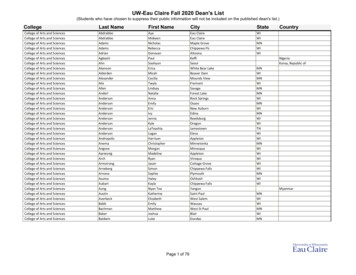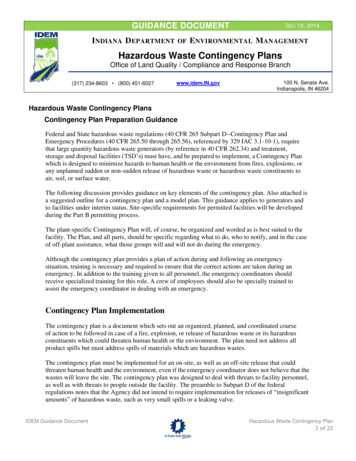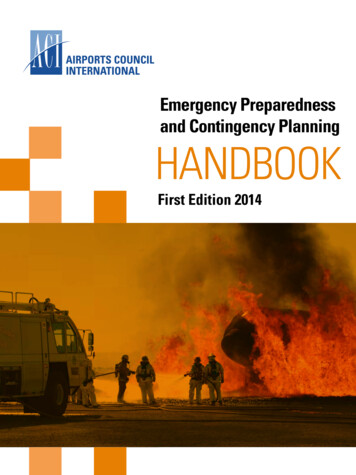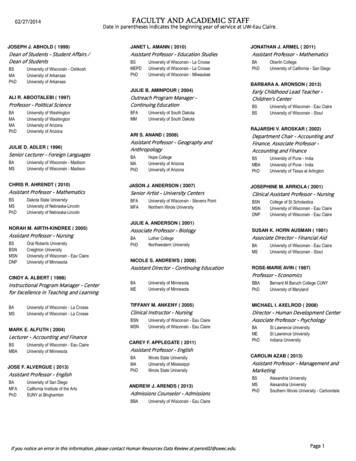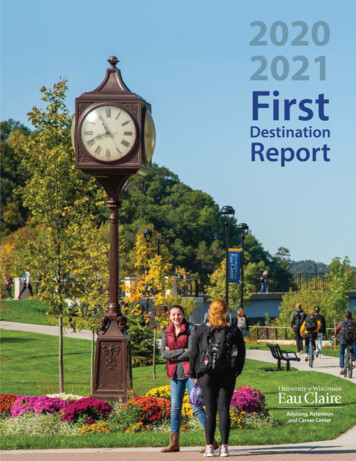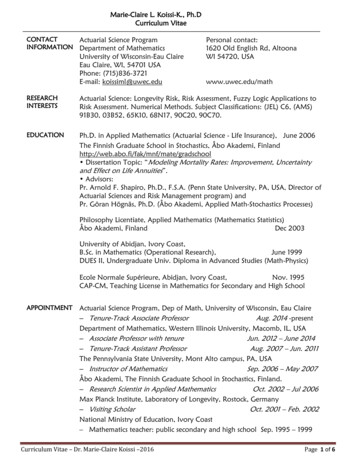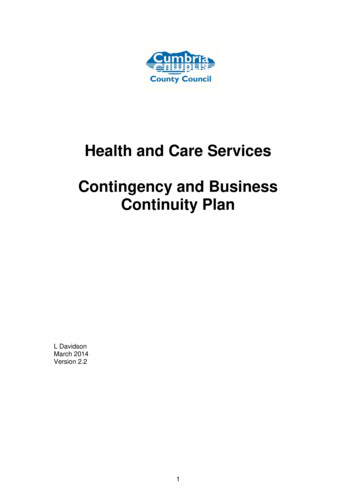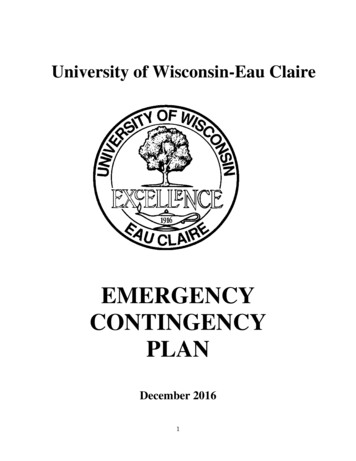
Transcription
University of Wisconsin-Eau ClaireEMERGENCYCONTINGENCYPLANDecember 20161
PREFACEThis Emergency Contingency Plan has been designed to provide a basic contingency manualfor UWEC administration in order to plan for campus emergencies and minimize the size of thedisaster/emergency as it occurs. While this guide does not cover every conceivable situation, itdoes supply the basic administrative guidelines necessary to cope with most campus emergencies.The UW-Eau Claire policies and procedures described herein are expected to be followed by alladministrators whose responsibilities and authority cover the operational procedures found in thisguide. Campus emergency operations will be conducted within the framework of the Universityguidelines. Any exceptions to those crisis management procedures will be conducted by, or withthe approval of, those University administrators directing and/or coordinating emergencyoperations.All requests for procedural changes, suggestions, or recommendations will be submitted in writingto the Office of Loss Prevention and Safety for technical review. The Office of Loss Preventionand Safety will forward all recommended changes in writing to the Vice Chancellor for StudentAffairs for approval.The Office of Loss Prevention and Safety will review and update this document every January.Changes will be distributed to all holders of this document. This handbook is provided to thosewho may need to respond to an emergency situation. A list of emergency contingency planholders can be found in Appendix A. A separate quick reference emergency procedure brochureis made available to all faculty, staff and students.The Director of Loss Prevention and Safety will work with other units to ensure policies and plansreferenced in this document are kept up-to-date.2
Table of ContentsEMERGENCY PROCEDURES GUIDETable of Contents . 19Active Shooter . 20, 21Bomb Threat . .22Civil Disturbance or Demonstration .23Disaster Recovery for Learning & TechnologyServices .24Emergency Telephone System .25Evacuation Procedures .26Explosion on Campus .27Medical and First Aid .28Fire .29Hazardous Substance Spill or Radiation/Spill/Release .30Flooding .31Severe Weather/Tornado .32Student Crisis .33Suspicious Package.34Violent or Criminal Behavior.35Utility Failure.36INTRODUCTIONPurpose .4Scope.4Definitions .4Assumptions/Guidelines .5Declaration of Campus State of Emergency .5Command Center .6Disabled Persons .6Accounting for All Persons .6Closing the University .6Post-Incident Critique .6CHANCELLOR’S EMERGENCY RESPONSE TEAMTeam Listing/Contact Information .7Chain of Command .8Other Emergency Contacts .9Chancellor’s Emergency Response Team .10Emergency Director .10Emergency Coordinator .10Damage Control .11University Police Office .11Public Information .11Hazardous Materials/Risk Management.11Student Affairs and Dean of Students.11Information Technology.11Academic Affairs .11Chancellor’s Office .12Affirmative Action .12APPENDIX AEmergency Contingency Plan Distribution Lis.37APPENDIX BBuilding Coordinators.38,39APPENDIX CCampus Map.40APPENDIX DRESPONSIBILITIESFirst Responder .13Administrators, Deans and Department Chairs .13Building Coordinators .14Faculty and Supervisors .14UW Campus Emergency Contacts at UW System Administration .41COMMUNICATION/NOTIFICATION SYSTEMSEquipment.15Chain of Notification .15Communication Failure .16SOURCES OF ASSISTANCEOn-Campus Directory.17Off-Campus Directory .18.3
INTRODUCTIONPURPOSEThe basic emergency procedures outlined in this guide are to enhance the protection of lives and property through theeffective use of campus and community resources. Whenever an emergency affecting the campus reaches proportionsTHAT CANNOT BE HANDLED BY ROUTINE MEASURES, the Chancellor, or his/her designee may declare a state ofemergency, and these contingency guidelines may be implemented.Since an emergency may be sudden and without warning, these procedures are designed to be flexible in order toaccommodate contingencies of various types and magnitudes.SCOPEThese procedures apply to all personnel, buildings, and grounds owned and operated by the University and include thoseperipheral areas adjoining the University of Wisconsin-Eau Claire, including Simpson Athletic Field and Bollinger Fields.See map found in Appendix C.DEFINITIONSThe following definitions of an emergency are provided as guidelines to assist in determining the appropriate response:a.MINOR INCIDENT: Any incident, potential or actual, which will not seriously affect the overallfunction of the University.b.EMERGENCY: Life-threateningc.MAJOR EMERGENCY: Any incident, potential or actual, which affects an entire building or buildingsand which will disrupt the overall operation of the University. Outside emergency services will probablybe required as well as major efforts from campus support services. Major policy considerations anddecisions will be required from the University Administration during a major emergency.d.DISASTER: Any event or occurrence, which has taken place and has seriously impaired or halted theoperations of the University. In some cases, personnel casualties and severe property damage may occur.A coordinated effort of all campus-wide resources is required to effectively control the situation. Outsideemergency services will be essential. In all cases of disaster, an Incident Command Center will beactivated, and operational plans will be developed and executed.4
ASSUMPTIONS/GUIDELINESThe University Emergency Contingency Plan is predicated on a realistic approach to the problems likely tobe encountered on campus during a major emergency or disaster. Hence, the following are generalguidelines:a.An emergency or a disaster may occur at any time of the day or night, weekend or holiday, withlittle or no warning.b.The succession of events in an emergency is not predictable; hence, published support andoperations plan will serve only as guides and checklists and may require field modification inorder to meet the requirements of the emergency.c.Disasters may affect the geographical location surrounding the University; therefore, City,County and Federal emergency services may not be available or may be delayed in providingassistance.d.This document serves as a guideline and, in many cases, refers the user to policies, plans,statutes, etc., that were already in place. If a major emergency or disaster were to occur,University Police personnel would follow existing rules and policies, including the EmergencyManagement Plan for Eau Claire County prepared by the Eau Claire County Office of EmergencyGovernment.DECLARATION OF CAMPUS STATE OF EMERGENCYThe authority to declare a campus state of emergency rests with the University Chancellor or his/her designee.During the period of any campus major emergency or disaster, the University Police Office may place intoimmediate effect the appropriate procedures necessary in order to meet the emergency, safeguard persons andproperty, and maintain facilities. University Police shall immediately consult with the Chancellor regardingthe emergency and the possible need for a declaration of a campus state of emergency.When a state of emergency has been declared, only registered students, faculty, staff, appropriate emergencypersonnel, and affiliates (i.e., persons required by employment) are authorized to be present on campus. Thosewho cannot present proper identification (registration or employee identification card or other I.D.) showingtheir legitimate business on campus will be asked to leave the campus. Representatives from the Press should bereferred to the Executive Director of University Communications.Only those individuals who have been assigned a member of the Chancellor’s Emergency Response Team and/orwho have been issued an emergency pass by the Campus University Police department will be allowed to enterthe immediate disaster site.Any emergency which has the potential for publicity should be promptly reported to the Executive Director ofUniversity Communications Office at 715/836-4742.5
COMMAND CENTERAn Incident Command Center may be established to direct building evacuations, coordinate rescue operations, dispatchvictims to local hospitals, and otherwise control the situation at the scene of the disaster. This center will provide directcommunication with area hospitals, emergency vehicles, police and fire personnel, and other local, county and stateassistance agencies. The Coordinator of the Chancellor’s Emergency Response Team will determine if a command centeris needed, and if so, where it will be located.DISABLED PERSONSDisabled persons should be assisted by their group members--class or work unit--in moving to shelter or evacuating froma building. Vision or hearing impaired persons should be assisted in moving to shelter or evacuating from a building. Mobility impaired persons should go to the nearest uninvolved (smoke free) stairwell landing. If possible,occupants of the building should assist the disabled person to shelter or out of the building. Leave allwheelchairs in the building, out of the pathway. If a disabled person cannot be taken from the building, adesignated staff person would meet emergency response personnel and advise if there are any individuals inneed of assistance, and where they are located.REMINDER: In case of fire or explosion, DO NOT USE THE ELEVATORS.ACCOUNTING FOR ALL PERSONSIt is suggested that keeping persons together by their naturally occurring groups, such as by classroom or residence hallfloor and wing, provides the most natural and workable framework for "head counting".CLOSING THE UNIVERSITYIf necessary, the Chancellor may close the University to the public, may cancel classes, and release employees. However,it takes an order by the Governor to close the University completely.When inclement weather threatens operations, the University will remain in operation to the extent possible. Refer to theInclement Weather Policy (2:17) located in the University Policy-book.POST-INCIDENT CRITIQUEA post-incident critique will be conducted as soon as practical following an emergency and/or disaster. The Directors ofthe Offices of University Police and Loss Prevention & Safety should jointly write the report incorporating input frommembers of the Chancellor’s Emergency Response Team. The report will be shared with the Chancellor and his/heradministrative staff.6
Chancellor's Emergency Response TeamRev. 12/2016OfficeAdministrationChancellor James Schmidt715/836-2327Provost, Patricia A. Kleine715/836-2320Mike Carney715/836-4494MJ Brukardt715/836-2320Teresa O'Halloran715/836-2387Suzanne Olson715/836-2327University PoliceDave Sprick715/836-2222Division of Student AffairsBeth Hellwig715/836-5992Joseph Abhold715/836-5992Loss PreventionJohn Baltes715/836-4414FacilitiesTroy Terhark715/836-2178CommunicationsMike Rindo715/836-4742Julie Poquette715/836-3985Daren Bauer715/836-5286LTS7CellHome
Chain of Command: James Schmidt, Chancellor Patricia A. Kleine, Provost and Vice Chancellor Beth Hellwig, Vice Chancellor of Student Affairs Mike Carney, Associate Vice Chancellor-Academic Affairs8
Other Emergency ContactsRev. 12/2016OfficeCellAdministrationSuzanne Cooley Olson715/836-2327University PoliceGeneral - 24 hours715/839-4972Division of Student AffairsJodi Thesing-Ritter715/836-2325Lynn Wilson715/836-5521Student Health ServiceLaura Chellman (SHS & CS)715/836-4311Pat Kress (SHS)715/836-4311Luke Fedie (CS)715/836-5521Colleen Marchwick (CIE)715/836-4874Housing and Residence LifeQuincy Chapman715/836-3630Deb Newman715/836-3675Facilities/Loss PreventionDiane Hunter715/836-3999Heating Plant715/836-4412CommunicationsJudy Berthiaume715/836-4745Jean Piper715/836-4003Tyler Schroeder - Web715/836-2360Eric Stevens - Servers715/836-6026Tom Paine - Network715/836-3078LTSNon-University ContactsEau Claire Police/Sheriff715/839-4972 (non-emergency)Eau Claire Fire715/839-5012 (non-emergency)Eau Claire County EmergencyPlanning715/839-4736 (24 hours)9Home
CHANCELLOR’S EMERGENCYRESPONSE TEAMWhen an emergency or disaster is impending or first occurs, the Director of University Police shall immediately begincontacting members of the Chancellor’s Emergency Response Team which consists of the following:TEAM MEMBERJOB TITLEWORK PHONEEmergency DirectorEmergency CoordinatorDamage ControlUniversity Police OfficePublic InformationHazardous Materials Mgmt./Loss Prevention & SafetyDean of StudentsInformation TechnologyAcademic AffairsAcademic AffairsChancellor’s OfficeAffirmative ActionVice ChancellorChancellor of UWEC or designeeDirector of University PoliceDirector of Facilities ManagementUniversity Police Officers & StaffExec. Dir. of Univ. 715/836-2222715/836-4742Director of Loss Prevention & SafetyDean of StudentsLearning and Technology ServicesProvost/Vice ChancellorAssociate Vice ChancellorStrategic Planning DirectorSpecial Assistant to the ChancellorStudent 992EMERGENCY DIRECTOR: Chancellor or designeea.b.c.d.Responsible for the overall direction of the UW-Eau Claire Emergency Response Team.Works with the University Police Director and others in assessing the emergency and preparing theUniversity’s specific response.Declares and ends, when appropriate, the campus state of emergency.Notifies and conducts liaison activities with University administration, governmental agencies,Chancellor’s Emergency Response Team, and others as necessary.EMERGENCY COORDINATOR: Director of University Policea.b.c.d.e.f.g.h.i.Responsible for the overall coordination of the university emergency response.Determines the type and magnitude of the emergency and establishes the appropriate emergencycommand center.Initiates immediate contact with the Chancellor and University administrative staff; begins assessment ofthe University’s condition.Notifies and utilizes police, Office of University Police personnel, and, if necessary, student aides in orderto maintain safety and order.Notifies the members of the Chancellor’s Emergency Response Team; advises them of the nature of theemergency.Notifies and conducts liaison activities with appropriate outside organizations such as the FireDepartment, Police Department, Division of Emergency Government, etc.Ensures that appropriate announcements are made to faculty, staff, and students, as well as the generalpublic.Performs other related duties as may be directed by nature of the campus emergency.In conjunction with the Director of Loss Prevention & Safety, prepares and submits a report to theChancellor appraising the final outcome of the emergency.10
DAMAGE CONTROL: Director of Facilities Managementa.b.c.d.e.f.g.Provides equipment and personnel to perform shutdown procedures, hazardous area control, barricadeplacement, damage assessment, debris clearance, emergency repairs, and equipment protection.Provides vehicles, equipment, and operators for transportation of personnel and supplies; assigns vehiclesto the Chancellor’s Emergency Response Team for emergency use.Obtains the assistance of utility companies as required for emergency operations.Furnishes emergency power and lighting systems as required.Surveys habitable space and relocates essential services and functions.Provides emergency generator fuel during actual emergency or disaster periods.Provides for storage of vital records at an alternate site; coordinates with building coordinators (seeAppendix B) for liaison and necessary support.UNIVERSITY POLICE OFFICE: University Police Officers and staffa.b.c.d.e.f.Maintains the University Police Office in a state of constant readiness.Takes immediate and appropriate action to protect life, property, and University records as necessary.Obtains assistance from the City, County, and Federal Government as required.Provides traffic control, access control, perimeter and internal security patrols, and fire preventionservices as needed.Establishes site for the emergency command center, if necessary.Maintains liaison with Ameritech for telecommunications support as necessary.PUBLIC INFORMATION: Executive Director of University Communicationsa.b.c.d.e.Establishes liaison with the news media for dissemination of information as requested by the Chancelloror designee.Establishes liaison with local radio and TV services for public announcements.Arranges for photographic and audio-visual services.Advises the Chancellor or designee of all news concerning the extent of the disaster affecting the campus.Prepares news releases for approval by the emergency director; distributes news releases concerning theemergency to the media.HAZARDOUS MATERIALS AND RISK MANAGEMENT: Director of Loss Prevention and Safetya.b.c.d.Provides technical and safety assistance to reduce hazards prior to and during emergencyor disaster conditions.Investigates and evaluates campus hazards for environmental health and industrial safety.In conjunction with the Director of University Police, prepares and submits a report tothe Chancellor appraising the final outcome of the emergency.Coordinates restoration of services/property for insurance purposes.STUDENT AFFAIRS and DEAN OF STUDENTS: Vice Chancellor of Student Affairs and Dean of Studentsa.b.Establishes liaison with residence halls and University centers.Liaison with parents of students.INFORMATION TECHNOLOGY: Learning and Technology Servicesa.Technology advisor to emergency response team.ACADEMIC AFFAIRS: Provost and Vice Provosta.Represent academic issues.11
CHANCELLOR’S OFFICE: Strategic Planning Directora.Advisor to emergency response team.AFFIRMATIVE ACTION: Special Assistant to Chancellora.Advisor to emergency response12
RESPONSIBLITIESFIRST RESPONDERa.Secure area and/or evacuate if appropriate.b.Call 9-911 or tell someone to do so.c.Assume that all threats of violence or destruction of property is real.d.Comply with demands if an intruder is involved and avoid escalating the confrontation.e.Discourage independent actions.f.Stay calm.g.Provide reassurance to students and staff.h.Do not speculate.i.Use professional judgment.j.Document the incident by providing a brief written summary.ADMINISTRATORS, DEANS, AND DEPARTMENT CHAIRSa.Inform all employees under their direction of the emergency condition.b.Evaluate what impact the emergency has on their activity and take appropriate action. Thismay include ceasing operations and initiating building evacuation.c.Maintain communication with Chancellor’s Emergency Response Team.d.Report all safety hazards to University Police and the Office of Loss Prevention and Safety.Work orders to reduce hazards and to minimize accidents should be promptly submitted toFacilities Management.13
BUILDING COORDINATORSa. Report all emergencies by calling 9-911.b. Inform occupants of the building of the emergency condition.c. Know where people should be directed.d. In the event of major building damage, help coordinate with Facilities Management alternatestorage of vital records.See Appendix B for a list of building coordinators.FACULTY AND STAFF SUPERVISORSa. Educate their students and/or employees concerning University emergency procedures as well asevacuation procedures for their building and/or activity.b. Inform their students and/or staff of the emergency condition.c. Evaluate what impact the emergency has on their activity and take appropriate action. This may includeceasing operations and initiating building evacuations.d. Report all safety hazards to University Police and Office of Loss Prevention and Safety. Work orders toreduce hazards and to minimize accidents should be promptly submitted to Facilities Management.14
COMMUNICATION/NOTIFICATION SYSTEMSEQUIPMENTThe telephone is the primary means of emergency notification at UWEC. During an emergency/disaster, the phonesystem is intended for the immediate transmission of specific information regarding an emergency to all affected areas ofthe campus and MUST be restricted to University business only.In the event of a disabled telephone system, communication can be accommodated through the use of existing two-wayradios and cellular telephones. The Office of University Police is responsible for providing the equipment and would bethe focal point for two-way transmission of official emergency telephone communications.CHAIN OF NOTIFICATIONIn the case of an emergency/disaster, the Director of the University Police Office, or his/her designee, notifies:WorkRoom #Chancellor .715/836-2327 . S204Executive Director of Communications .715/836-4742 . S204Provost and Vice Chancellor.715/836-2320 . S206Dean of Students .715/836-5992 . S240Vice Chancellor Student Affairs .715/836-5992 . S240Executive Director-ASK Center .715/836-2517 .B273Home.The administrators listed above are responsible for notifying all departments under their direction.15
COMMUNICATION FAILUREIn case of communication outage:1.Notify ATT as soon as possible:a.Dial 1-877-888-5622 press 5 and 1 for ATT Repair Service.b.Dial 715/839-5649 or 715/410-2206 (cell) or call Mark Mohr 608/250-8711 for localATT Manager.c.If you cannot locate a phone, go to the Office of University Police (Crest WellnessCenter 119), and they will contact ATT.2.Report the following information:a.Type of damage (e.g., fire in main telephone room in Schofield Hall)b.Extent of outage.c.Duration of outage.3.Do not assume someone else has contacted ATT unless their vehicles are on campus.4.ATT will determine how long it will take to restore services. Alternative routing or communicationswill be considered at this time. Once the restoration time is determined, members of the Chancellor’s EmergencyResponse Team will decide whether alternative routing and/or other means of communication are needed.5.The following phones should be restored first:AREATELEPHONE NUMBERLOCATIONUniversity Police .836-2222836-4262 .Crest Wellness Center lor’s Office .836-2327836-5607836-2320836-5305836-3566 Schofield 204836-4742836-4353836-5775University Communications 836-4741836-4745836-3985 Schofield 201Facilities Management 836-5278 . .Maintenance & Central Stores 102Custodial Services .836-5817 . .Hibbard Hall 110Residence Halls HousingBridgmanGovernorsHoranMurrayTowers (north & 598855-4600855-4667855-4726855-2614Lobby ofResidenceHallsFacilities Planning .836-5125 . Maintenance & Central Stores 107Children’s Nature Academy 836-2178 . . .Campus School 100ATelephone Services. . .836-3000 or 836-4272 .Schofield 17BUniversity Centers & Programs . 836-2263 or 836-2637 .Davies Center 107Student Health Services . 836-4311 . .Crest Wellness Center 150Heating Plant .836-4412 . . .Heating PlantHuman Resources .836-2513 Schofield 22616
SOURCES OF ASSISTANCEON-CAMPUSExecutive Director – Ask Center . 715/836-2517Assistant Chancellor for Facilities . 715/836-4742Central Stores . 715/836-3742Chancellor . 715/836-2327Counseling Services . 715/836-5521Deans:College of Arts and Sciences . 715/836-2542College of Business. 715/836-5509College of Education and Human Sciences . 715/836-3671College of Nursing and Health Services . 715/836-5287Dean of Students . 715/836-5992Emergency Dispatcher . 9-911Facilities Management . 715/836-5278Facilities Planning. 715/836-5125Housing and Residence Life . 715/836-3674Human Resources . 715/836-2513Learning and Technology Services . 715/836-5711Loss Prevention and Safety . 715/836-4414Multicultural Affairs . 715/836-3367Provost and Vice Chancellor. 715/836-2320Purchasing . 715/836-5171Receiving . 715/836-3742Student Affairs . 715/836-5992Student Health Services . 715/836-4311Student Senate. 715/836-4646Telephone Services .
7 Chancellor's Emergency Response Team Rev. 12/2016 Office Cell Home Administration Chancellor James Schmidt 715/836-2327 Provost, Patricia A. Kleine 715/836-2320 Mike Carney 715/836-4494 MJ Brukardt 715/836-2320 Teresa O'Halloran 715/836-2387 Suzanne Olson 715/836-2327 University Police

